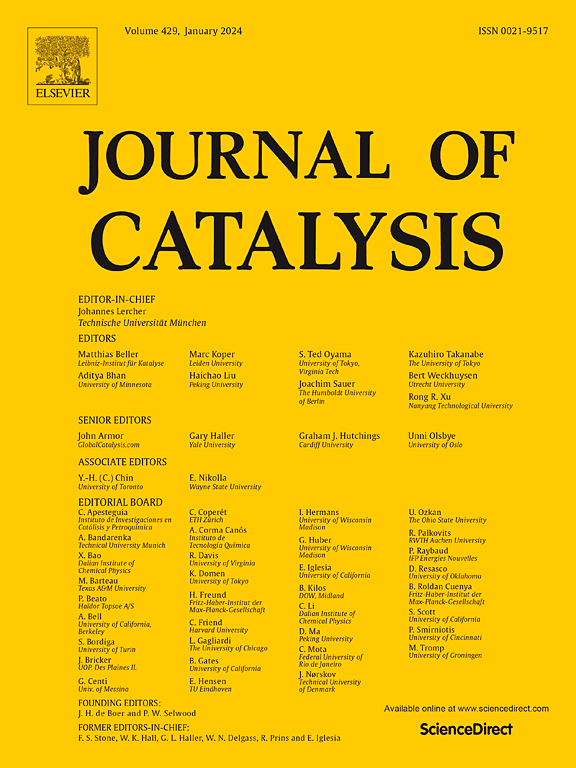负载Pd催化剂在苯酚加氢脱氧中的作用:基于第一线原理的微动力学建模的见解
IF 6.5
1区 化学
Q2 CHEMISTRY, PHYSICAL
引用次数: 0
摘要
生物质热解衍生生物油的催化加氢脱氧(HDO)是生物油在用作燃料之前降低其氧含量的关键步骤。在这方面,生物油模型化合物的HDO已经在许多负载金属催化剂上进行了研究,但负载对催化活性的作用在很大程度上被忽视了。本文研究了苯酚-生物油模型化合物在Pd/Al2O3、Pd/ZrO2和Pd/TiO2催化剂上的HDO反应机理。利用第一性原理密度泛函理论(DFT)计算,阐明了苯酚活化成苯和环己酮的综合反应图和多种反应途径的能量学。金属支撑界面为反应物和中间体的吸附提供了独特的场所,从而改变了反应机理,从而改变了产物的分布。在TiO2和ZrO2载体上,苯酚吸附在Pd-载体界面上,苯酚O与氧化物载体的亲氧阳离子结合,将碳环向Pd,从而削弱羰基O键,促进其裂解生成苯。在Al2O3的情况下,苯酚仅通过Pd上的环碳吸附,产生环氢化产物,如环己酮。微动力学分析表明,Pd/ZrO2和Pd/TiO2的直接脱氧途径更有利于苯的生成,而Pd/Al2O3的通过苯氧中间体生成环己酮的途径更有利,与实验结果一致。本文章由计算机程序翻译,如有差异,请以英文原文为准。


Role of support in phenol hydrodeoxygenation over supported Pd catalysts: Insights from first-principles based microkinetic modelling
Catalytic Hydrodeoxygenation (HDO) of biomass pyrolysis-derived bio-oil is a critical step for reducing oxygen content in the bio-oil, before its utilisation as a fuel. In this regard, HDO of bio-oil model compounds have been investigated over numerous supported metal catalysts, but the role of support on the catalytic activity has been largely ignored. In this work, the reaction mechanism for HDO of phenol – a bio-oil model compound was investigated on Pd/Al2O3, Pd/ZrO2 and Pd/TiO2 catalysts. Comprehensive reaction map and energetics of the multiple reaction pathways for phenol activation to benzene and cyclohexanone were elucidated using first-principles Density Functional Theory (DFT) calculations. The metal-support interface provides a unique site for the adsorption of the reactants and the intermediates, which alter the reaction mechanism and consequently the product distribution. Over TiO2 and ZrO2 supports, phenol adsorbs on the Pd-support interface with the phenolic O binding to oxophilic cation of the oxide support and ring carbon to Pd, thereby weakening the Caryl-O bond and facilitating its cleavage to form benzene. In the case of Al2O3, phenol adsorbs only through the ring carbon on the Pd, which results in ring-hydrogenated products like cyclohexanone. A microkinetic analysis revealed the direct deoxygenation pathway to benzene to be favoured over Pd/ZrO2 and Pd/TiO2, while cyclohexanone production via a phenoxy intermediate was favoured on Pd/Al2O3, in agreement with experimental results.
求助全文
通过发布文献求助,成功后即可免费获取论文全文。
去求助
来源期刊

Journal of Catalysis
工程技术-工程:化工
CiteScore
12.30
自引率
5.50%
发文量
447
审稿时长
31 days
期刊介绍:
The Journal of Catalysis publishes scholarly articles on both heterogeneous and homogeneous catalysis, covering a wide range of chemical transformations. These include various types of catalysis, such as those mediated by photons, plasmons, and electrons. The focus of the studies is to understand the relationship between catalytic function and the underlying chemical properties of surfaces and metal complexes.
The articles in the journal offer innovative concepts and explore the synthesis and kinetics of inorganic solids and homogeneous complexes. Furthermore, they discuss spectroscopic techniques for characterizing catalysts, investigate the interaction of probes and reacting species with catalysts, and employ theoretical methods.
The research presented in the journal should have direct relevance to the field of catalytic processes, addressing either fundamental aspects or applications of catalysis.
 求助内容:
求助内容: 应助结果提醒方式:
应助结果提醒方式:


